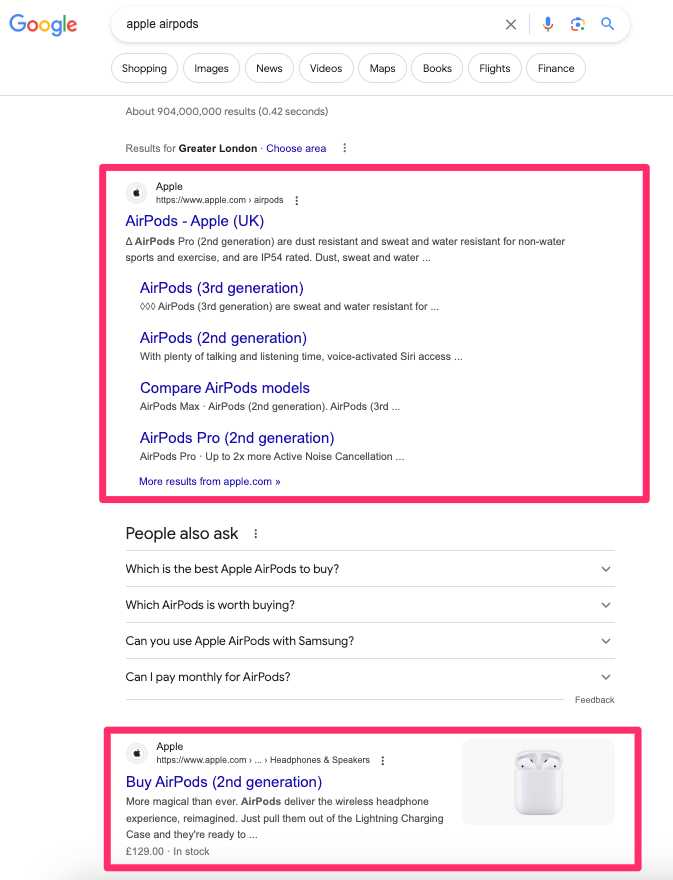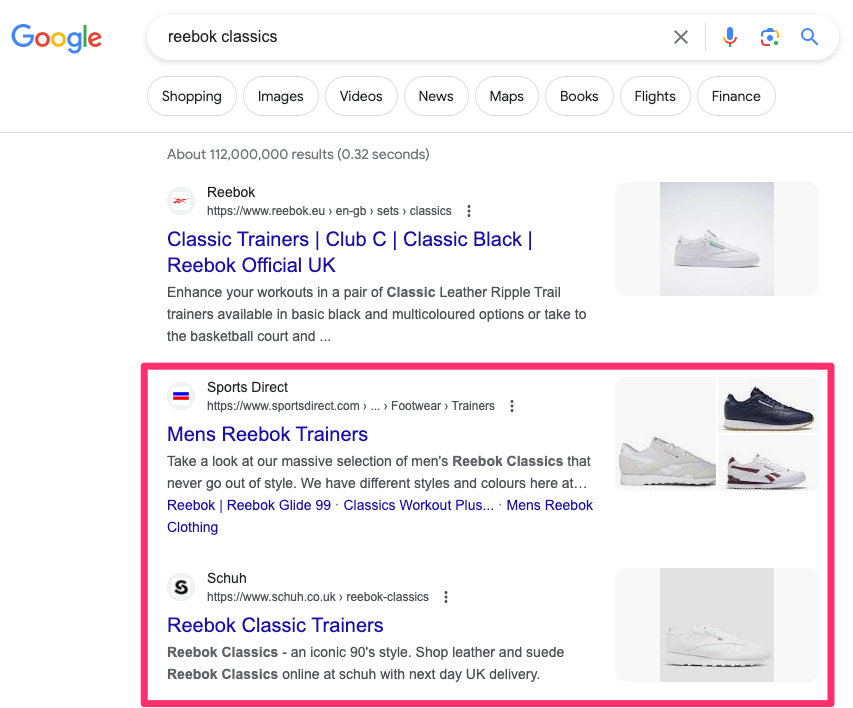In most ecommerce verticals, DTC (Direct To Consumer) ecommerce sites compete head-on with the retailers and distributors who stock their products. Furthermore, with few exceptions (such as Apple) brands tend to give their retailers sizeable discounts which can then be passed onto retail customers. So unless the retailer is unknown or untrustworthy, there’s little reason to shop direct. Unless DTC stores can compete on price and guarantee to be the cheapest, customers will need to be enticed in other ways.
At some point during the digital buying cycle, a customer is likely to search for something on Google and click on a top result. This could be researching the best brands, the newest features, comparing prices, to obtain social proof (I bought the top 10 wireless headphones, guess who came out on top!) or simply to click through and make a purchase. Retailers again have an upper hand with this – they don’t really care if your new running shoes are Nike or Adidas, as long as they get the sale. So they can happily stack Nike and Adidas against each other on category pages, comparing prices and offering honest buyer reviews for social proof. It hits every stage of the buying process, and you’ll often see these pages appearing for your own brand keywords on Google.
Protecting your brand SERP real estate
If you’re selling laptops DTC, competing for the keyword [laptops] is a tough challenge. Much easier (one would hope) is ranking for [dell laptop] if you’re Dell or [asus laptop] if you’re ASUS. But there will still be retailers eating your lunch on those keywords, even if you’re ranking #1. They might offer the lowest prices, faster delivery, loyalty points or better information. As well as tackling those selling points head-on, we also want to push their Google listings further down the page.

Apple are masters of this. You can buy their headphones on Amazon, Argos or John Lewis, but you’ll probably never see those results. Each of their product ranges has long detailed landing pages, showing every feature and advantage of the products. Then each individual product has its own landing page beneath that, showing that product’s specific feature set. Then there’s a comparison page, so that you don’t need to leave the Apple website to compare and decide which product to buy. Once you have chosen to buy, the PDP (Product Detail Page) is also a separate page, with more commercial content and the ability to customise your device, which the retailers can’t offer. Each of these pages adds a lot of value to the buyer’s experience and also pushes the retailers further down Google’s search results. So unless your initial search query was something generic like [headphones] and you hadn’t thought about Apple, you’ll probably only buy your AirPods directly from the Apple website.

Unlike Apple, Reebok does not appear to have a glossy “Reebok Classics” landing page for the UK market, talking about their history, origin, features, quality and appeal. Just a rather generic standardised PLP (Product Listing Page). Below reebok.eu (is Britain still in the EU?) on Google.co.uk, are price focussed retailers Sports Direct, Schuh, JD Sports and ASOS, offering an alternative route to purchase. So much more could be done to prevent clicks from being lost to these retailers.
Reebok could create new pages covering topics such as:
- Who created the Classic?
- Why was it designed?
- What are the unique features?
- Who was famous for wearing them?
- What occasions should you wear them for?
- What are the types of Classic shoes within the range?
- How do their materials and comfort compare?
There is so much valuable information missing that could easily build out into several new landing pages. As long as each page is highly unique and targets either a different product or part of the buying cycle, they will all be seen as valuable by Google (and customers). These additional pages would create a virtual moat around Reebok’s listings for brand + product terms, pushing down the retailers.
Increasing your SERP opportunities
As well as gaining multiple listings on brand/trademark keywords, another moat building tactic is to target every relevant SERP feature that Google offers. The more features you target, the more visibility you’ll gain over retailers, and your customers will benefit from it as well.
Some examples include:
- Featured Snippets – Dedicate part of your ecommerce site to a knowledge base, with both detailed and summarised information on matters close to your product range. Sell running shoes? Provide information about every possible injury, foot type and technique used in running. Sell car parts? Create a gold mine of information on every part of a car, what it does and what can go wrong.
- People Also Asked – You most likely have a helpdesk and perhaps even canned responses to common customer questions. These questions and answers should be hosted on your ecommerce site, not hidden away in a customer portal or CRM. Failing that, use a tool such as AlsoAsked or Semrush to show you questions that people search for on Google, relating to your products. If structured properly, this can start generating traffic from long tail queries and clicks from the PAA box on search results.
- Structured Product Data – Ensure that your PDPs are correctly rendering valid Schema data, that all relevant values are filled, they pass a spot test and to keep monitoring them in Google Search Console. Don’t forget about Reviews either – one study estimated that stars on your search result snippet could increase clicks by 35%. Plus keep monitoring new Schema types for rich results – there’s a ProductCollection schema in the planning stages which would be perfect for PLPs.
- Sitelinks Search Box – Mostly shown on exact brand searches, but another real traffic win, the Sitelinks Search Box directs searches from your Google listing to your store’s internal search results.
- Knowledge Panels – A blessing and a curse (sometimes listing competitor brands), a Knowledge Panel consumes a large amount of SERP real estate and helps to convey trust in your brand. Getting a knowledge panel to appear can be as simple as adding Organization schema to your brand’s homepage, but quite often also requires some Digital PR and mentions/citations in trustworthy publications. Once your brand is in the Knowledge Graph, it’s important to claim and verify your listing, then monitor it for errors and outdated content.
- Image Schema and Best Practice – Give as much detail about your product imagery as possible in your
<img>attributes and Schema, with multiple size/resolution options, so that your images are more likely to appear for product searches, than your retailers do. There’s nothing wrong with holding back some imagery and product video content for your brand’s exclusive use, as retailers will do this with their own media content. - Product Compendiums – You know your brand’s products better than anybody, so become the font of all knowledge. Every measurement, colour, material, feature, angle, usage, button. Any question that a customer could potentially have about your products, should be found on your website, along with any manuals, user guides, care guidelines and instructions. You’d be surprised how much traffic this generates from new customers doing their research and existing customers who might buy again from you.
Improving click-through rates
It’s possible to entice a potential customer to your brand website, even if a retailer ranks above you in Google. People tend to scan all visible search listings in Google and may not necessarily choose to click on the first advert or organic listing. They look for what Google defines as E-E-A-T (Experience, Expertise, Authoritativeness, and Trustworthiness). If your website appears better suited to answering the searcher’s question, they may skip the listings above and go straight to your website.
There are different degrees to which a brand can achieve this, depending on its relationships with retailers. Some of the most effective strategies might be looked negatively upon by wholesale customers. Options open to brands include:
- Official – You are the only official website for your brand, so mention this in your page titles and/or meta descriptions so that it appears in search results. “Official Website” and “The only official store of X” can dramatically boost clicks.
- Price Guarantee – Common with hotels and sometimes B2C products, brands can offer the “lowest price guaranteed, or your money back”. If a potential customer sees this in the search results, they’re more likely to choose your listing, at the buying stage of their journey.
- Trust – If you’re buying a set of Bose headphones, who could be more trustworthy to buy from than Bose themselves? This is a strong emotional lever for ad/meta copy, “The name you can trust”.
- Prestige – Offer customers access to an exclusive loyalty/discount club, free extended warranty or additional support/setup services when they buy direct. Apple again are very good at making their direct customers feel special, to the extent that few people buy outside an Apple Store, online or offline.
Looking for assistance crafting a strategy to attract more customers for direct shopping? Contact our team for support.



